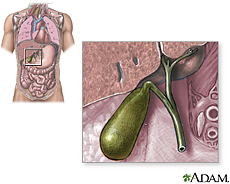 |
 |
 |
Other Health Topics:

-
Related Topics
-
Go Local
- Services and providers for Gallbladder Diseases in the U.S.
-
National Institutes of Health
- The primary NIH organization for research on Gallbladder Diseases is the National Institute of Diabetes and Digestive and Kidney Diseases
Languages
- Arabic (العربية)
- Chinese - Simplified (简体中文)
- Chinese - Traditional (繁體中文)
- French (français)
- Hindi (हिन्दी)
- Japanese (日本語)
- Korean (한국어)
- Portuguese (português)
- Russian (Русский)
- Somali (af Soomaali)
- Spanish (español)
- Ukrainian (Українська)
- Vietnamese (Tiếng Việt)
Your gallbladder is a pear-shaped organ under your liver. It stores bile, a fluid made by your liver to digest fat. As your stomach and intestines digest food, your gallbladder releases bile through a tube called the common bile duct. The duct connects your gallbladder and liver to your small intestine.
Your gallbladder is most likely to give you trouble if something blocks the flow of bile through the bile ducts. That is usually a gallstone. Gallstone attacks usually happen after you eat. Signs of a gallstone attack may include nausea, vomiting, or pain in the abdomen, back, or just under the right arm.
Many gallbladder problems get better with removal of the gallbladder. Fortunately, the gallbladder is an organ that you can live without. Bile has other ways of reaching your small intestine.
| Basics | Learn More | Multimedia & Cool Tools |
|---|---|---|
| Research | Reference Shelf | For You |
-
Overviews
- Gallbladder Disorders(Merck & Co., Inc.)
-
Latest News
- Body Mass Index Linked with Runners' Gallbladder Disease Risk(09/12/2008, Reuters Health)
- Hormone Replacement May Raise Women's Gallbladder Risk(07/11/2008, HealthDay)
-
Diagnosis/Symptoms
-
ERCP (Endoscopic Retrograde Cholangiopancreatography)
 (National Institute of Diabetes and Digestive and Kidney Diseases)
(National Institute of Diabetes and Digestive and Kidney Diseases)
- HIDA Scan (Cholescintigraphy): Why Is It Performed?(Mayo Foundation for Medical Education and Research)
-
Ultrasound - Abdomen(American College of Radiology, Radiological Society of North America)
Also available in Spanish
-
Understanding EUS (Endoscopic Ultrasonography)(American Society for Gastrointestinal Endoscopy)
Also available in Spanish
-
ERCP (Endoscopic Retrograde Cholangiopancreatography)
-
Treatment
-
Cholecystectomy - Open and Laparoscopic
 (Patient Education Institute) - Requires Flash Player
(Patient Education Institute) - Requires Flash Player
Also available in Spanish
- Cholecystectomy: Surgical Removal of the Gallbladder(American College of Surgeons) - Links to PDF
-
Gallbladder Removal: Laparoscopic Method(American Academy of Family Physicians)
Also available in Spanish
- Therapeutic ERCP (Endoscopic Retrograde Cholangiopancreatography)(American Society for Gastrointestinal Endoscopy)
-
Cholecystectomy - Open and Laparoscopic
-
Specific Conditions
- Biliary Colic(InteliHealth, Harvard Medical School)
- Cholecystitis(InteliHealth, Harvard Medical School)
- Gallbladder Polyps(Mayo Foundation for Medical Education and Research)
-
JAMA Patient Page: Acute Cholecystitis(American Medical Association)
Also available in Spanish
-
Related Issues
- Chronic Diarrhea: A Concern After Gallbladder Removal?(Mayo Foundation for Medical Education and Research)
-
Tutorials
-
Cholecystectomy - Open and Laparoscopic(Patient Education Institute) - Requires Flash Player
Also available in Spanish
- Digestive System: The Inside Story(Johns Hopkins Medicine) - Requires media player
-
Cholecystectomy - Open and Laparoscopic(Patient Education Institute) - Requires Flash Player
-
Videos
- Laparoscopic Cholecystectomy(OR-Live) - Requires Flash Player - one hour program
-
Clinical Trials
-
ClinicalTrials.gov: Cholecystectomy
 (National Institutes of Health)
(National Institutes of Health)
-
ClinicalTrials.gov: Gallbladder Diseases
 (National Institutes of Health)
(National Institutes of Health)
-
ClinicalTrials.gov: Cholecystectomy
-
Journal Articles
References and abstracts from MEDLINE/PubMed (National Library of Medicine)
- Article: Spectrum of biliary and nonbiliary complications after laparoscopic cholecystectomy: radiologic...
- Article: More than just stones: a pictorial review of common and...
- Article: Trends in surgical management for acute cholecystitis.
- Gallbladder Diseases -- see more articles
- Medical Encyclopedia Return to top
-
Organizations
- American Gastroenterological Association
-
National Digestive Diseases Information Clearinghouse

-
National Institute of Diabetes and Digestive and Kidney Diseases

-
Children
- Cholecystitis Acalculous - (Gallbladder Inflammation without Gallstones)(American Pediatric Surgical Association)
| Home | Health Topics | Drugs & Supplements | Encyclopedia | Dictionary | News | Directories | Other Resources | |
| Disclaimers | Copyright | Privacy | Accessibility | Quality Guidelines U.S. National Library of Medicine, 8600 Rockville Pike, Bethesda, MD 20894 National Institutes of Health | Department of Health & Human Services |
Date last updated: 15 September 2008 Topic last reviewed: 14 July 2008 |






